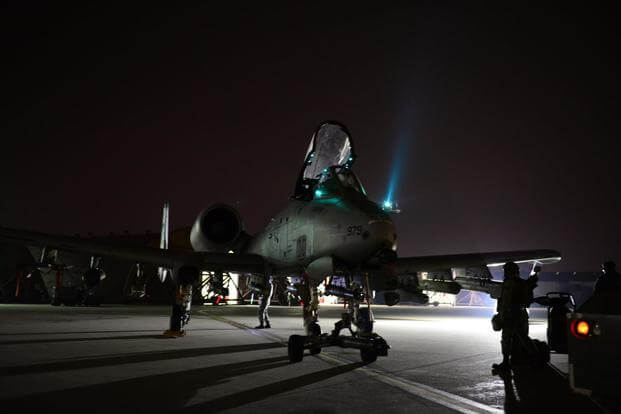A-10 Thunderbolt II attack aircraft operating out of Incirlik airbase in Turkey provided "devastating" close air support for U.S.-backed Syrian-Arab fighters in taking a town in northwestern Syria from the Islamic State, a U.S. military spokesman said Wednesday.
The A-10s were joined by an AC-130 Spectre gunship in clearing the way for the U.S.-aligned group now known as the Syrian Arab Coalition to take the town of al-Hawl and 250 square kilometers of surrounding area in fighting Monday and Tuesday, said Army Col. Steve Warren, a spokesman for Combined Joint Task Force-Operation Inherent Resolve.
"We were able to bring both the A-10s and the Spectre gunship to bear in a devastating manner" to aid in the assault on al-Hawl, Warren said.
Warren's comments were believed to be the first by the U.S. military in describing a specific attack in the campaign against the Islamic State in Iraq and Syria, or ISIS, by the A-10s, commonly known as "Warthogs" to the U.S. infantry. A-10s flying out of unidentified bases in the Mideast have also been used against ISIS in Iraq.
The slow-flying A-10, featuring a 30 mm GAU-8/A seven-barrel Gatling-type cannon, began flying in 1976 but is still considered by many the best close air support weapon in the Air Force inventory. For years, the service has tried to retire the A-10s but Congress has continued to provide funding and did so again in this year's National Defense Authorization Act.
In a video briefing from Baghdad, Warren said the A-10s and the AC-130 allowed about 1,000 Syrian Arab fighters to take al-Hawl from an ISIS force believed to number several hundred.
Backed by 17 U.S. airstrikes and using American-supplied ammunition, the advancing Syrian Arab fighters killed at least 79 ISIS defenders, Warren said.
"The Syrian Arab Coalition showed us valor," he said. "They showed us something here, and we're pleased with that."
The A-10s used in the attack on al-Hawl were among about a dozen Thunderbolts recently deployed to Incirlik. The A-10s were to be joined in the coming weeks by about a dozen F-15 fighters, according to the Pentagon.
The approval by Turkey for the use of Incirlik against ISIS in Syria has aided the U.S. in supporting a variety of groups fighting ISIS in northern Syria, Warren said.
"Our flight legs are shorter, our loiter time is longer" out of Incirlik, giving the U.S. "more air power in the battlespace," he said. The use of other bases in the Mideast for strikes in Syria required "two mid-air refuelings on the way up, two on the way back," he said.
The al-Hawl operation also showed promise for the new U.S. effort to re-supply anti-ISIS fighters in Syria while working through vetted leaders of about a dozen groups under the umbrella of the Syrian Arab Coalition, Warren said.
"It's not a complete validation, I want to be clear," of the program to back the Syrian Arab Coalition, he said, "but we're encouraged."
The new effort began after the U.S. abandoned the $500 million program to train and equip a new anti-ISIS Syrian force of about 5,000 fighters in Turkey and send them back into Syria. More than $43 million was spent on that effort before it was dropped, according to the Pentagon.
On Oct. 12, the U.S. airdropped about 50 tons of ammunition to the Syrian Arab Coalition, Warren said. He echoed previous U.S. statements that none of the ammunition went to the Kurdish-Syrian YPG (Popular Democratic Forces).
The YPG, considered the most effective anti-ISIS force fighting in Syria, is opposed by Turkey. YPG leaders have charged in recent weeks the Turkish troops have fired on their positions from across the border.
The apparent success in the taking al-Hawl contrasted with the long-stalled effort by the Iraqi Security Forces (ISF), backed by U.S. airstrikes, to retake the Anbar province city of Ramadi, from which they fled in May.
Warren said the Ramadi campaign was stalled again as the ISF sought to cut off an ISIS re-supply route across the Route 1 bridge over the Euphrates River. The Islamic State of Iraq and Syria (ISIS) was also using barges and other watercraft on the Euphrates to bring weapons and fresh fighters into Ramadi, Warren said.
"That river is full of traffic," Warren said, and the U.S. was having difficulty distinguishing between civilian and ISIS boats for airstrikes. "We're not going to strike every single vessel we see, we have to be confident that we know what we're striking," he said.
Even if the bridge and water traffic were cut off, "then it's on to the really hard part which is urban fighting" to retake Ramadi, Warren said. "That is going to be a difficult, hot, dangerous, scary fight. It will take a while."
--Richard Sisk can be reached at Richard.Sisk@military.com.





























